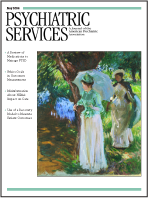Reel Psychiatry: Movie Portrayals of Psychiatric Conditions
It is clear from reading psychiatrist David Robinson's new book, Reel Psychiatry: Movie Portrayals of Psychiatric Conditions, that the author put some time and thought into conceiving and researching this project. A strong feature of the book is clear and concise discussions of DSM axes, accompanied by detailed expositions of related symptoms and conditions as they present themselves in film story lines. Kindred books use DSM more perfunctorily and, quite frankly, less effectively.
Drawing attention to inconsistencies and inaccuracies in diagnoses and symptom presentation in a particular film is another of the book's strengths. This alert affords the lay or professional reader more confidence in the prescription of certain films for clinical or educational purposes. Yet, refreshingly, the author is not a pedant. He is not put off by cinematic inaccuracies or faults in clinical treatment to the degree that powerful film portrayals would be precluded from consideration or inclusion in a discussion. Ordinary People and Good Will Hunting are cases in point. (Barbra Streisand's portrayal of a psychiatrist without boundaries in The Prince of Tides is, mercifully, not.)
The book, however, has its share of flaws. The chapter structures are inconsistent, commencing with section 2. Annoyingly poor judgment is evident in instances in which the author makes multiple references to films at different points in the same chapter. In these instances, the first reference to the film provides less sufficient contextualization of the discussed scenes and dynamics than does the second. More careful editing would have prevented this problem.
There is also an omission that frustrates: It would have been useful if Robinson had provided the reader with release dates of cited films so that potential viewers could know what filmmaking style and period to expect. My own research and experience with using films to demonstrate psychiatric conditions to viewers under the age of 30 has revealed that pre-1960s filmmaking styles and films shot in black and white have a tendency to detract from a film's intended clinical or educational impact. Advance warning of these generational differences in filmmaking can prevent putting off the audience.
The exposition of plot points in films that depict mental retardation are not so much omitted as covered anemically. The reader would benefit from more story narrative to fully grasp how well the films illustrate the condition. On a related note, the book's total absence of coverage of autism is regrettable.
Minor flaws aside, I believe that Reel Psychiatry is an excellent resource for people who are interested in recommending films in venues where a film discussion is a valuable vehicle for advancing the process of education or psychotherapy. I would also recommend the book to screenwriters, novelists, and playwrights. Any writer who needs to accurately create fictional characters with a variety of psychiatric symptoms can happily use this book as a resource. The book also aids in identifying films that have attempted and either failed or succeeded to render various psychiatric portrayals accurately. As a part-time screenwriter and a full-time psychologist, I will strongly recommend this book to colleagues in both fields.
Dr. Fischoff is professor of media psychology at California State University, Los Angeles.



